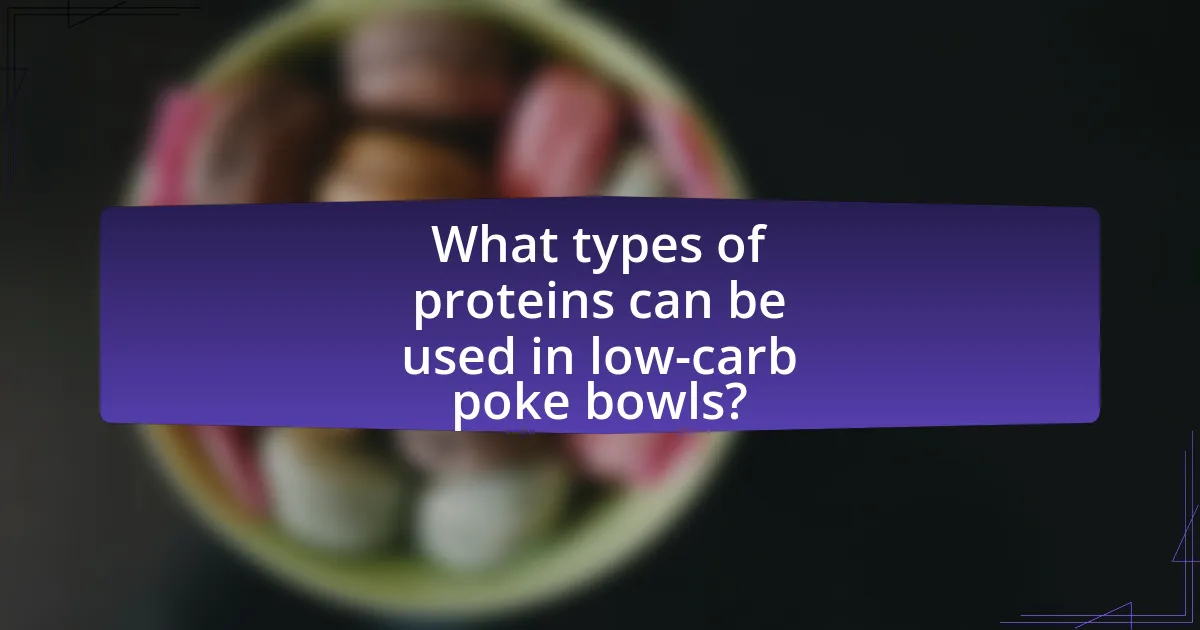Low-carb poke bowl options for keto dieters focus on using ingredients that are low in carbohydrates while providing essential nutrients. Key components include cauliflower rice as a base, various protein sources such as raw fish, tofu, and chicken, and low-carb vegetables like avocado and cucumber. These bowls align with keto dietary guidelines by emphasizing high healthy fat and protein content while minimizing carbohydrate intake. The article also explores the health benefits of low-carb poke bowls, including support for weight loss and improved blood sugar control, as well as practical tips for customizing and preparing these meals at home.

What are Low-Carb Poke Bowl Options for Keto Dieters?
Low-carb poke bowl options for keto dieters include using cauliflower rice instead of traditional rice, incorporating protein sources like raw fish (such as salmon or tuna), and adding low-carb vegetables like cucumber, avocado, and seaweed. These ingredients maintain a low carbohydrate count while providing essential nutrients. For instance, cauliflower rice contains approximately 5 grams of carbs per cup, significantly lower than regular rice, which has about 45 grams. Additionally, fatty fish like salmon are rich in omega-3 fatty acids, beneficial for overall health while fitting into a keto diet.
How do low-carb poke bowls fit into a keto diet?
Low-carb poke bowls fit into a keto diet by providing a meal option that is low in carbohydrates and high in healthy fats and proteins. These bowls typically consist of a base of low-carb ingredients such as leafy greens or cauliflower rice, topped with protein sources like raw fish, tofu, or chicken, and complemented by keto-friendly toppings like avocado, sesame seeds, and low-sugar sauces. The combination of these elements allows individuals following a ketogenic diet to maintain their carbohydrate limits while enjoying a nutritious and flavorful meal.
What ingredients are typically used in low-carb poke bowls?
Low-carb poke bowls typically include ingredients such as raw fish (like tuna or salmon), leafy greens (such as spinach or kale), avocado, cucumber, radishes, and low-carb sauces (like soy sauce or sesame oil). These ingredients are chosen for their low carbohydrate content, making them suitable for keto dieters. For instance, a standard serving of avocado contains about 2 grams of net carbs, while leafy greens are often less than 1 gram of net carbs per serving, supporting the low-carb dietary requirements.
How do these ingredients align with keto dietary guidelines?
The ingredients in low-carb poke bowl options align with keto dietary guidelines by being low in carbohydrates and high in healthy fats. For instance, ingredients like avocado, fatty fish (such as salmon or tuna), and low-carb vegetables (like cucumber and seaweed) provide essential nutrients while maintaining a low carbohydrate profile. The ketogenic diet typically restricts carbohydrate intake to about 20-50 grams per day, and these ingredients help achieve that by offering minimal carbs while supplying healthy fats and proteins, which are crucial for ketosis.
What are the health benefits of low-carb poke bowls for keto dieters?
Low-carb poke bowls offer significant health benefits for keto dieters by providing a nutrient-dense meal that aligns with their dietary restrictions. These bowls typically contain high-quality proteins, such as fish or tofu, which support muscle maintenance and repair while being low in carbohydrates. Additionally, the inclusion of healthy fats from ingredients like avocado or sesame oil promotes satiety and aids in the absorption of fat-soluble vitamins.
Research indicates that low-carb diets can lead to improved weight management and better blood sugar control, making poke bowls an ideal choice for those following a ketogenic lifestyle. The combination of fresh vegetables in poke bowls also contributes essential vitamins and minerals, enhancing overall health without exceeding carbohydrate limits.
How do low-carb poke bowls support weight loss on a keto diet?
Low-carb poke bowls support weight loss on a keto diet by providing a meal option that is high in healthy fats and low in carbohydrates, which aligns with the macronutrient ratios necessary for ketosis. These bowls typically include ingredients like fresh fish, avocado, and low-carb vegetables, which help maintain satiety and reduce overall calorie intake. Research indicates that diets low in carbohydrates can lead to greater fat loss compared to higher-carb diets, as evidenced by a study published in the American Journal of Clinical Nutrition, which found that participants on a low-carb diet lost more weight and body fat over a 6-month period compared to those on a low-fat diet.
What nutritional advantages do low-carb poke bowls provide?
Low-carb poke bowls offer several nutritional advantages, primarily by providing high protein content while minimizing carbohydrate intake. These bowls typically include ingredients such as fresh fish, which is rich in omega-3 fatty acids, promoting heart health and reducing inflammation. Additionally, low-carb poke bowls often incorporate non-starchy vegetables like cucumbers and seaweed, which are low in calories and high in vitamins and minerals, contributing to overall nutrient density. The reduction in carbohydrates can also aid in weight management and improve blood sugar control, making them suitable for individuals following a ketogenic diet.

What types of proteins can be used in low-carb poke bowls?
Low-carb poke bowls can utilize proteins such as raw fish, cooked seafood, chicken, and tofu. Raw fish options include salmon and tuna, which are low in carbohydrates and high in healthy fats and protein. Cooked seafood like shrimp and crab also fits well within a low-carb framework. Chicken provides a lean protein source, while tofu serves as a plant-based alternative, offering a low-carb option for those following vegetarian or vegan diets. These protein choices align with the nutritional goals of a low-carb or ketogenic diet, which emphasizes high protein and low carbohydrate intake.
Which fish options are best for keto-friendly poke bowls?
Salmon and tuna are the best fish options for keto-friendly poke bowls. Both salmon and tuna are high in healthy fats and low in carbohydrates, making them ideal for a ketogenic diet. Salmon contains approximately 20 grams of protein and 13 grams of fat per 100 grams, while tuna offers around 30 grams of protein and 1 gram of fat per 100 grams. These nutritional profiles support the macronutrient ratios required for ketosis, ensuring that individuals can enjoy flavorful poke bowls without exceeding their carb limits.
How do different fish varieties impact the carb content?
Different fish varieties generally have low to negligible carbohydrate content, making them suitable for low-carb diets like keto. For instance, salmon, tuna, and mackerel contain virtually no carbs, while some fish like tilapia may have trace amounts. The carbohydrate content in fish is primarily influenced by the species and preparation methods, with most fish being naturally low in carbs. According to the USDA FoodData Central, a 3-ounce serving of raw salmon contains 0 grams of carbohydrates, reinforcing the idea that fish is an excellent choice for those seeking low-carb options in dishes like poke bowls.
What are the benefits of using raw versus cooked fish in poke bowls?
Using raw fish in poke bowls offers benefits such as enhanced flavor and texture, while cooked fish provides safety and digestibility. Raw fish, like sushi-grade tuna or salmon, retains more omega-3 fatty acids, which are beneficial for heart health, and offers a fresher taste that complements the dish’s overall profile. In contrast, cooking fish eliminates potential parasites and bacteria, making it safer for consumption, especially for those with compromised immune systems. Additionally, cooked fish can be easier to digest for some individuals, providing a different culinary experience that can appeal to various preferences.
What non-fish protein alternatives are available for poke bowls?
Non-fish protein alternatives available for poke bowls include tofu, tempeh, chicken, beef, and shrimp. Tofu and tempeh provide plant-based protein options that are low in carbohydrates, making them suitable for keto dieters. Chicken and beef offer lean meat choices that can be marinated and served in poke bowls, while shrimp is a seafood alternative that is not classified as fish but still provides a high-protein option. These alternatives cater to various dietary preferences while maintaining the essence of a poke bowl.
How do chicken and tofu compare in terms of carb content?
Chicken contains significantly fewer carbohydrates than tofu. Specifically, a 3-ounce serving of cooked chicken breast has approximately 0 grams of carbohydrates, while the same serving size of firm tofu contains about 3 grams of carbohydrates. This difference makes chicken a more suitable option for those following a low-carb or ketogenic diet, as it helps maintain lower overall carbohydrate intake.
What are the best preparation methods for non-fish proteins in poke bowls?
The best preparation methods for non-fish proteins in poke bowls include marinating, grilling, and sautéing. Marinating proteins such as chicken, tofu, or tempeh enhances flavor and tenderness; a typical marinade might include soy sauce, sesame oil, and ginger. Grilling adds a smoky flavor and appealing texture, making it ideal for chicken or beef, while sautéing provides a quick cooking method that retains moisture and flavor, suitable for tofu or vegetables. These methods align with low-carb dietary preferences, ensuring that the proteins remain flavorful and satisfying without adding unnecessary carbohydrates.

How can you customize low-carb poke bowls for personal preferences?
You can customize low-carb poke bowls for personal preferences by selecting specific proteins, vegetables, and sauces that align with your taste and dietary needs. For instance, choose proteins like tuna, salmon, or tofu, which are low in carbs and high in healthy fats. Incorporate non-starchy vegetables such as cucumbers, radishes, and seaweed to enhance flavor and texture without adding significant carbohydrates. Additionally, opt for low-carb sauces like soy sauce, sesame oil, or a homemade vinaigrette to complement the ingredients while keeping the carb count low. This customization allows for a personalized meal that adheres to a keto diet while satisfying individual flavor preferences.
What low-carb toppings can enhance poke bowls?
Low-carb toppings that can enhance poke bowls include avocado, cucumber, radishes, seaweed salad, and sesame seeds. Avocado provides healthy fats and a creamy texture, while cucumber adds crunch and freshness with minimal carbs. Radishes contribute a peppery flavor and are low in carbohydrates, making them a great addition. Seaweed salad offers umami flavor and is rich in nutrients, and sesame seeds add a nutty taste and texture without significantly increasing carb content. These toppings not only complement the flavors of poke bowls but also align with low-carb dietary preferences.
How do toppings like avocado and seaweed contribute to a keto diet?
Toppings like avocado and seaweed significantly contribute to a keto diet by providing healthy fats and low carbohydrates. Avocado is rich in monounsaturated fats, which support ketosis, while containing only about 2 grams of net carbs per 100 grams, making it an ideal choice for maintaining low carbohydrate intake. Seaweed, on the other hand, is low in calories and carbohydrates, offering about 1 gram of net carbs per 100 grams, and is also a source of essential nutrients like iodine and fiber, which can aid digestion and overall health. Together, these toppings enhance the nutritional profile of keto meals while keeping carbohydrate levels in check.
What sauces are keto-friendly for poke bowls?
Keto-friendly sauces for poke bowls include soy sauce, tamari, sesame oil, and avocado oil. These sauces are low in carbohydrates and fit within the macronutrient guidelines of a ketogenic diet. For example, soy sauce contains approximately 1 gram of carbs per tablespoon, making it a suitable option. Tamari, a gluten-free alternative, also has a similar carb content. Sesame oil and avocado oil are primarily fats, containing negligible carbohydrates, thus aligning well with keto dietary requirements.
How can you ensure your poke bowl remains low-carb?
To ensure your poke bowl remains low-carb, focus on selecting low-carb ingredients such as leafy greens, non-starchy vegetables, and protein sources like fish or tofu. Leafy greens like spinach or kale serve as a base instead of rice, which is high in carbohydrates. Non-starchy vegetables, such as cucumbers, radishes, and bell peppers, add crunch and flavor without significantly increasing carb content. Additionally, opting for protein-rich toppings like salmon, tuna, or marinated tofu provides essential nutrients while keeping the overall carb count low. By avoiding high-carb additions like rice, sweet sauces, and fruits, you can effectively maintain a low-carb poke bowl suitable for a keto diet.
What common ingredients should be avoided in poke bowls for keto?
Common ingredients to avoid in poke bowls for keto include rice, high-sugar sauces, and certain fruits. Rice is high in carbohydrates, which can disrupt ketosis, while sauces like teriyaki or sweet soy contain added sugars that increase carb content. Fruits such as mango and pineapple are also high in sugars and should be excluded to maintain low carbohydrate intake.
How can portion control help maintain low-carb intake in poke bowls?
Portion control helps maintain low-carb intake in poke bowls by allowing individuals to manage the quantity of high-carb ingredients, such as rice and certain toppings. By limiting the serving size of these components, one can significantly reduce the overall carbohydrate content of the meal. For example, a standard serving of sushi rice contains approximately 45 grams of carbohydrates, while a smaller portion can cut this down to around 15 grams, aligning better with low-carb dietary goals. This strategic management of portions ensures that the poke bowl remains compliant with low-carb or ketogenic dietary requirements, promoting better adherence to these eating plans.
What are some practical tips for making low-carb poke bowls at home?
To make low-carb poke bowls at home, start by using cauliflower rice or zucchini noodles as a base instead of traditional rice. This substitution significantly reduces carbohydrate content while maintaining a satisfying texture. Incorporate fresh, low-carb vegetables such as cucumber, radishes, and avocado for added flavor and nutrients. Choose protein sources like raw fish, shrimp, or tofu, which are low in carbs and high in protein. For flavor, use low-carb sauces like soy sauce or sesame oil, and add toppings such as seaweed, sesame seeds, or chopped green onions. These ingredients not only enhance taste but also keep the dish aligned with low-carb dietary goals.



